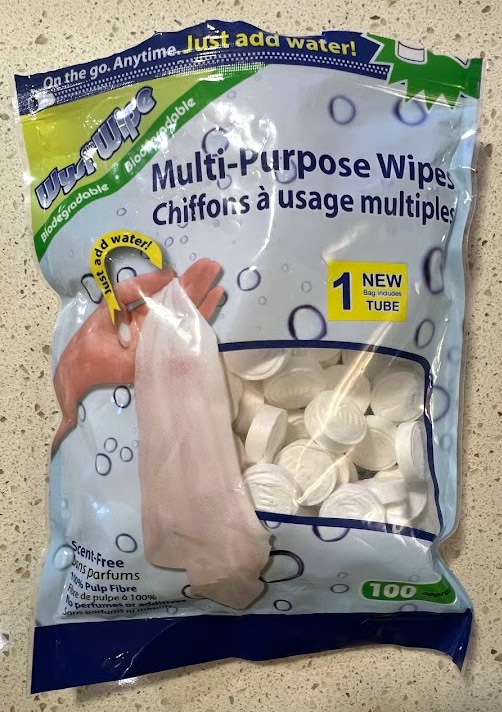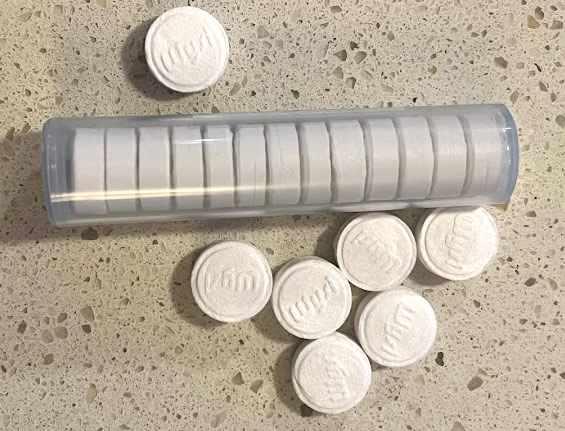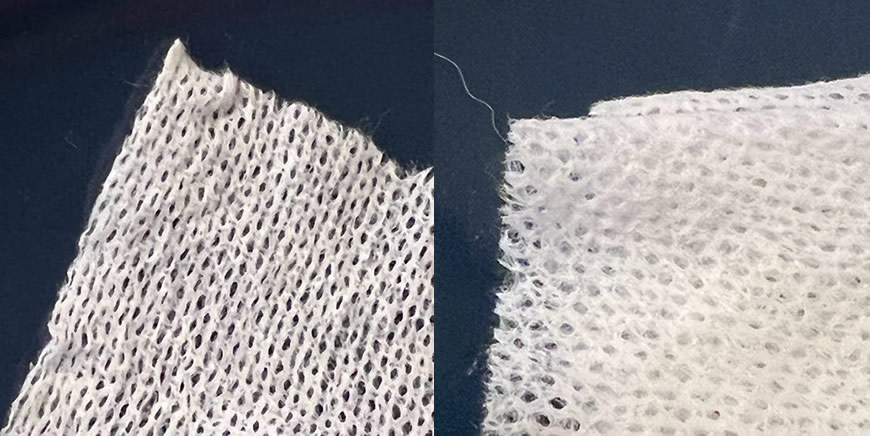Imagine this: You are on foot, crossing through forested land after a catastrophic event. You’re still a day away from your safe house when suddenly, nature calls. You know that to avoid that nasty tingly feeling later in the day, you need to wipe – but with what? When you packed your bugout bag, you couldn’t justify how much room a whole roll of toilet paper would take up but hadn’t yet considered a good alternative.

A toilet paper tablet is a small sheet of nonwoven cellulose or cotton that has been compressed down to the size of a coin. It is easy to carry, and its small size takes up much less room in an emergency pack than most other toilet paper alternatives. They turn from small tablets to useable toilet paper with as little as a teaspoon of water.
I’ve explored countless TP options to pack in my bugout bag over the years, and these tablets may be my favorite. Keep reading to find out what’s great – and not so great – about toilet paper tablets.
What is a Toilet Paper Tablet?

A toilet paper tablet is a small sheet of cloth-like material compressed into a tablet. The brand I have the most experience with, Wysi Wipes, has three different sizes of tablets; the smallest is about the diameter of a nickel. There are several other brands, and they all work the same way. Add a bit of water, and use them as you like.
These tablets are not the same as household toilet paper. Compressed toilet paper tablets are sheets of cellulose material similar to bleach wipes – but thinner. They are stronger than normal toilet paper but still pliable. Since they’re soft to the touch and contain no chemical additives, toilet paper tablets are fine for sensitive skin.
Why You Need Toilet Paper Tablets In Your Bugout Bag – And Everywhere Else
The simplest answer is that they’re better than a toilet paper roll. When was the last time you saw a well-traveled roll of toilet paper? I bet it didn’t look that great – toilet paper rolls don’t travel well. They also take up more room, are prone to disintegrate, and will take on any moisture.
Though other methods of packing regular household toilet paper in your bugout bag exist, none compare to the toilet paper tablet. I’ve tried vacuum packing unrolled toilet paper, and while it does take up much less room than a full roll, it’s still regular toilet paper with all the same issues.
Napkins are tougher and can take more abuse than regular toilet paper, but they still use more valuable space than a toilet paper tablet. Napkins are also more likely to scratch your bottom.
Others swear by premoistened wipes, like baby wipes or wet wipes, which take up more room and can spread their premoistened-ness all over. (Their stinky, perfumey, premoistened-ness. All over my go bag. Never again.)

The only real downside to tablets is that they expand when accidentally exposed to moisture. Even then, they’re still usable. I usually just use the travel tube in the package, as it’s pretty good at protecting the tablets, but it’s not entirely reliable.
If moisture is a concern, find a portable size watertight container, such as this one.
Never get the tablets that are individually wrapped. Not only is it incredibly wasteful, but in a survival situation, it’s just another piece of litter that could lead others to you. Leave no trace.
How to Use Toilet Paper Tablets
I’ll spell it out for you because this is the internet, and you can’t actually see the wipes. I’ll even put in some crappy pictures. (No pun intended.)
First, wet the toilet paper tablet with a few drops of water.
It takes only a teaspoon of water to unroll the small Wysi Wipes, which I imagine would be the same amount needed for wipes of similar size. A teaspoon is only 5ml or 1/6 of a fluid ounce – no matter how you slice it, that’s not much.
Second, unroll the sheet.
Make sure to get your wipes ready before you head to your spot. Though the tablets soak up the water quickly, it feels like it’s something you should do in advance.
Third, use it like regular toilet paper.
You can manipulate the cloth a little bit. If you gently pull it one way, you can make it less of a square shape and more of a longer rectangle closer to actual toilet paper. Fold or crumple at will, and wipe away.
I took this video to show you just how little water it takes to unroll a small tablet. The little measuring beaker I used is a 5ml beaker, and not all the water was used.
Like my little beaker? It’s made by OXO, and is available here.
How To Properly Dispose of After Use
When you’re done with the toilet paper tablet, either bury it with your deposit or safely throw it away. The tablets are entirely biodegradable and will decompose over a matter of weeks. They are safe to dispose of in outhouses and pit latrines/toilets.
They are safe to compost, both in your backyard or bin managed by your city. Some facilities may require you to bag wipes contaminated with feces or other bodily fluids in a compostable bag. Composting them into your veggie garden is not a great idea, as fecal matter can contaminate your produce.
Warning: Toilet paper tablets are not safe to flush, even if they are marked flushable. They are not septic tank safe, and they can clog plumbing in houses or RVs. Even at the city level, wipes clog up the sewer system. And it’s not just the city’s problem. According to the Patty Potty, an informational initiative from Save Water Texas, huge costs to continually clear out ‘clogbergs’ are always passed onto taxpayers.
So, what makes normal toilet paper safe for plumbing? Regular household toilet paper is designed to disintegrate soon after it’s submerged – in minutes. Toilet paper tablets and most other wipes will dissolve eventually, but not nearly fast enough to avoid binding with other materials and causing clogs.

Other Uses for Toilet Paper Tablets
You can use toilet paper tablets for other things besides wiping your rear. I don’t reserve them for just my go bag; I put them in my emergency kit at home. I keep them in the car, as the kids like using them to clean up. I take them camping and hiking, and I’ve even used them as coasters. (They work great, by the way.)
General Hygiene
Because toilet paper tables are absorbent, you can use them as a napkin or facial tissue in a pinch. Because they are strong, they can be rinsed out and used as a washcloth for those wilderness sponge baths. A hydrated toilet paper tablet will absorb any dirt, grime, or sweat and hold onto them until rinsed out. You might even want to look for some larger tablets for this reason. They’re often referred to as compressed paper towels.
Firestarter
We’ve all been there. You’re out in the woods, trying to get a fire going. Your supply of firestarter is running low, or maybe it isn’t catching fire for whatever reason.
Toilet paper tablets make for great tinder. When in compressed form, they can burn slowly and steadily. When expanded and dried, they burn slightly longer and hotter than regular toilet paper.
Spills and Cleaning
Have a small spill? Dab at it with a toilet paper tablet, and you don’t even need to activate it beforehand. A single tablet can soak up spills quickly. Because they are single-use, you don’t have to worry about cross-contamination.
You can also use them as dusting cloths or to clean your glasses. I’ve noticed toilet paper tablets don’t leave lint behind like regular toilet paper, which is suitable for cleaning sensitive equipment.
Turn Into an Antibacterial Wipe
Since there are no harmful ingredients, there is very little concern about what you can wet them down with. Pack small waterproof containers with antibacterial agents such as bleach, rubbing alcohol, vinegar, or even lemon juice. These liquids will all work with a portable wipe but don’t mix them unless you know what you’re doing.
Wound Care
Though they aren’t a replacement for a sterile dressing or for bandaging wounds, toilet paper tablets can be used to clean minor cuts and scrapes. To turn them into a hygienic wipe, you can hydrate them with any liquid, including saline, alcohol, or hydrogen peroxide. A compressed toilet paper tablet will absorb blood and keep the wound clean until you can properly treat it.
Because tablets are chemical and lint-free, they won’t gum up the injury, but they are not ideal for use as a wound dressing, as they will stick to and become part of any blood clots and scabbing.
Are Compressed Towels and Toilet Paper Tablets Environmentally Friendly?
The short answer is not really. On the one hand, these tablets are biodegradable. After you finish them, they will compost and break down completely, making them ideal from a zero-waste perspective. On the other hand, manufacturing processes are not very eco-friendly as every step of the process, from farming the tree to delivery, will add to their carbon footprint. But then again, so does everything else.
Toilet paper tablets are made of certain fibers that vary depending on the manufacturer. Although cotton is sometimes used, Viscose (aka Viscose Rayon), cellulose, and pulp are the most common fibers.
The procedures for creating Viscose, cellulose, and pulp fiber are similar. The main component is derived from specific types of trees. While the finished product is considered safe, eco-friendly, and hypoallergenic, the manufacturing process is highly polluting. Chemical agents such as carbon disulfide and sodium hydroxide are frequently discarded into nearby waterways after being exhausted.
There are also concerns about the impact of viscose production on deforestation, as tree farms are often expanded to meet the demand for this fabric. In many ways, Viscose is the ‘palm oil’ of the textile fiber world, and there is a growing movement to find more sustainable alternatives to this fabric.
Cotton is not much better. Like Viscose, cotton farming also brings fears of deforestation. Expansion of cotton farming continues because cotton is produced more than almost any other fiber, second only to polyester. Though it is a natural fiber, current mass farming practices use large amounts of land, water, and pesticides.
Some producers are switching to more environmentally friendly methods of producing cotton, such as using fewer chemicals and sustainable land and water use. Though these methods are clearly better, they are more expensive. I wouldn’t bet that we would find such materials in compressed toilet paper tablets. (Prove me wrong, manufacturers!)
Conclusion
Toilet paper tablets are one of the better toilet paper alternatives to pack in a survival pack. Though they have some drawbacks, such as clogging plumbing and septic systems, the benefits outweigh the negatives. They take up less room than toilet paper, are easy to use, and are biodegradable.
Now imagine this: You’re on foot, miles from what’s left of civilization. You get that feeling that you will soon need to make a pit stop. Thankfully, you remembered to pack a few tablets in your EDC bag. Of all the worries you have, a dirty anus is not one of them.


